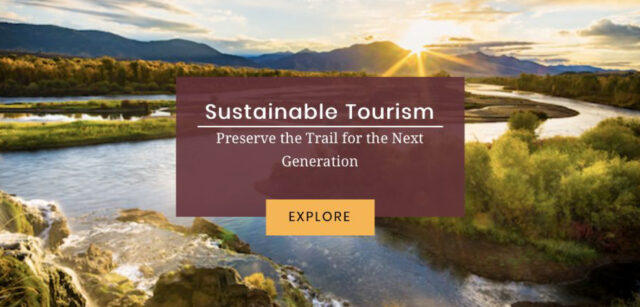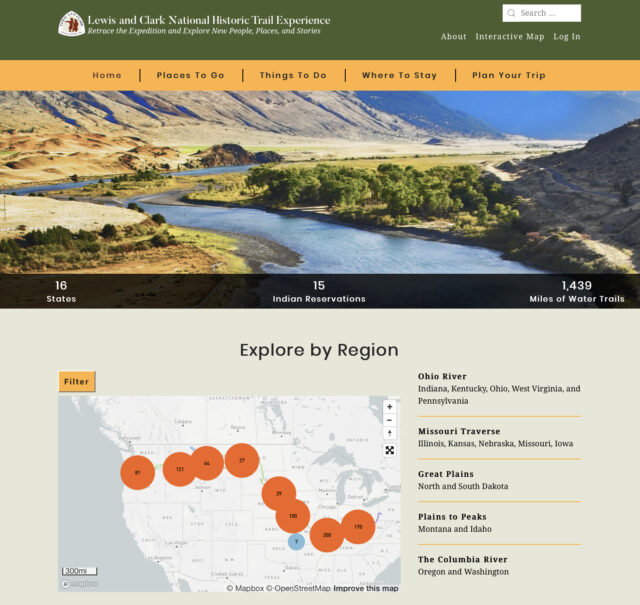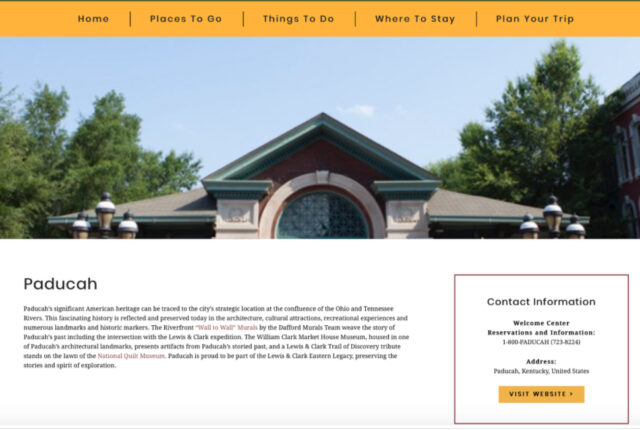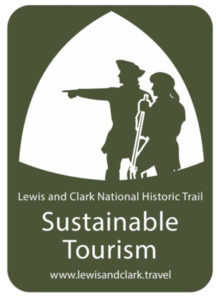Building sustainable tourism
Public-private partnerships elevate historic trail experience through website
by Derek Schimmel, Lewis and Clark National Historic Trail Experience Project Manager, Solimar International

Pittsburgh to the Pacific Ocean. 16 States. 15 American Indian reservations. 4,900 miles. 200-plus years of United States history.
Community interconnectivity is vital to build sustainability along long-distance trails. For the Lewis and Clark National Historic Trail (LCNHT), tourism has been used to achieve this connectedness and enhance community engagement.
The Lewis and Clark National Historic Trail is administered by the National Park Service (NPS) and follows some of America’s main river arteries as it passes through dozens of counties. Unlike the national scenic trails that are centered around long-distance hiking, the LCNHT covers 6,157 miles of auto route and 1,439 miles of water trails. As such, the sustainability of the trail is heavily reliant on public and private partnerships. Federal land managers, State tourism offices, chambers of commerce, nonprofit organizations, and individual volunteers all play a role in advocating and advancing the trail’s mission.
Dan Wiley, the Senior Manager of Integrated Resources Stewardship at the Lewis and Clark National Historic Trail, recognizes the value of the LCNHT in sustaining the history and culture of the Corps of Discovery. “The Purpose of the Lewis and Clark National Historic Trail is to commemorate the 1803 to 1806 Lewis and Clark Expedition through the identification; protection; interpretation; public use and enjoyment; and preservation of historic, cultural, and natural resources associated with the expedition and its place in U.S. and Tribal history,” he said.

GEOTOURISM: SHAPING THE TRAIL EXPERIENCE
Data obtained from the NPS suggests that over 3.1 million people visited at least one point along the Lewis and Clark National Historic Trail in 2017. These sites include Tribal museums, visitor centers and local, State, and Federal parks, not to mention the countless restaurants, hotels, and campsites situated along the trail. Despite an eclectic group of stakeholders and millions of visitors, the LCNHT was lacking a common thread that allowed destinations and stakeholders to share a common identity.
Enter Geotourism. Geotourism is defined as tourism that sustains or enhances the geographic character of a place, its environment, culture, aesthetics, heritage, and the well-being of its residents. It encompasses a wide-range of cultural travel including heritage, history, food, nature, adventure, the outdoors, water, music, and the arts. In short, this methodology celebrates any aspect of culture that makes a destination unique.
Geotourism creates a link between the past and the present for communities along the trail, regardless of its place in history as it relates to the Corps of Discovery. Take two locales along the LCNHT, for example. Paducah, KY is located on the banks of the Ohio River and offers visitors phenomenal hiking trails and breweries serving up beer made with hops from nearby farms. Also, 600 miles northwest, in Omaha, NE, history buffs will find plaques signifying campsites where the Corps of Discovery spent time hunting and fishing over 200 years ago. Bringing these two individual visitor experiences together onto one platform is a prime example of how Geotourism is being implemented along the Lewis and Clark National Historic Trail.
Paducah is one of over 50 community partners of the LCNHT Experience. When asked about Paducah’s partnership, Laura Oswald, Director of Marketing for the Paducah Convention and Visitors Bureau, said, “The Paducah CVB recognizes the value of Geotourism for sustainable tourism impact in Paducah and as a connector among places along the entire Lewis and Clark National Historic Trail. When tourism effectively weaves together cultural heritage and contemporary experiences, the result is an augmented sense of place and visitor impact.”

LOCAL, AUTHENTIC TOURISM: LCNHT AND BEYOND
The framework of Geotourism was founded by National Geographic in 2002, and since then several regions around the world have used this methodology to give tourism leaders and stakeholders the chance to be the storytellers for their destination.
Numerous Geotourism programs have been developed in the U.S. and abroad. The Scenic Wild Delaware River, the Rocky Mountain Region around the U.S.-Canada border, and the Sedona Verde Valley all have incorporated Geotourism into their overall tourism landscape domestically, while overseas the European Atlantic Geotourism Route highlights Western Europe’s local product offerings. Other similar programs can be seen around South Asia, as well as in Central and South America.
Still, the Lewis and Clark National Historic Trail Experience is the first of its kind in that no other historic trail has used Geotourism to build community engagement and celebrate the future while honoring the past. Currently, the program’s platform, Lewisandclark.travel, is live and is accepting nominations for communities, sites, attractions, and businesses to feature on its digital map guide. In the spring of 2021, the project will begin to be promoted to the traveling public in collaboration with the National Park Service and its community partners along the trail, including the Lewis and Clark Trust, Inc. and Lewis and Clark Trail Heritage Foundation.
In the meantime, the team at the Lewis and Clark National Historic Trail will soon begin implementing a content and communications plan designed to educate partners that have already joined the program. Each month, a different topic will be explored via virtual seminars and expert interviews. Content pillars will be centered around the history of the Lewis and Clark Expedition, citizen science, and the restarting/reimagination of tourism—all with the overstory of achieving economic and cultural sustainability inside destinations along the trail. This strategy will also be hugely instrumental in creating rich stories and trip ideas that will ultimately enhance the visitor experience.
Virtually any trail (whether they are a national scenic or historic trail) that passes through numerous destinations or communities is well-positioned to adapt both Geotourism and this education-based tourism strategy. Though National Geographic no longer directly promotes this program nor their digital map guides, tourism consultancies like Solimar International are trained and have the experience necessary to garner community buy-in and build the online platform needed for methodology to succeed.

Nowadays, it is seemingly impossible to write an article with tourism as a main subject without mentioning COVID-19. As a result of the global pandemic, the tourism ecosphere has been flipped upside-down and has forced destinations and trails to reimagine tourism as visitors venture out once again. Now more than ever, localization and authenticity are vital to the sustainability of the industry as a whole. Through the power of storytelling and Geotourism, the Lewis and Clark National Historic Trail Experience has found a way to commemorate the Corps of Discovery while celebrating and promoting the values and traditions of today’s American communities.
Learn more about the Lewis and Clark National Historic Trail Experience: lewisandclark.travel
Unless otherwise indicated, all material in Pathways Across America is public domain. All views expressed herein are perspectives of individuals working on behalf of the National Trails System and do not necessarily represent the viewpoint of the Federal agencies.